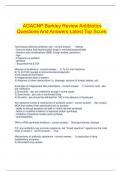AGACNP Barkley Review Antibiotics
Questions And Answers Latest Top Score.
Host factors affecting antibiotic use - correct answer. - Allergy
- Immune status (use bacteriacidal drugs in immunocompromised)
- Infection site complications (BBB, foreign bodies, perfusion)
- Age
- Pregnancy & lactation
- genetics
- drug enzymes & DDI
Misuses of Antibiotics - correct answer. 1) Tx for viral infections
2) Tx for FUO (except in immunocompromised pts)
3) No bacterial information
4) Inappropriate dose or patient
5) Absence of other interventions i.e. drainage, removal of foreign bodies, etc.
Examples of inappopriate Abx prescription - correct answer. 1) Common cold - abx
are ineffective
2) Bronchitis - abx are ineffective except in some cases
3) Sore throat - abx only in confirmed Strep
4) Sinusitis - abx should be withheld for 10D in the absence of facial pain
Abx selective toxicity & mechanism of antibiotic action - correct answer. Abx unique
MOA that makes them selectively toxic to bacteria
- ability to disrupt bacterial cell wall or inhibit cell wall synthesis
- lethal or nonlethal inhibition of bacterial protein synthesis
- inhibition of bacterial nucleic acid synthesis
- antimetabolites
DNA or RNA synthesis inhibitors - correct answer. fluoroquinolones, rifampin
T/F: any antibiotic may promote resistance, but *broad spectrum* agents are the most
likely to cause it - correct answer. True
Mechanisms of antibiotic resistance - correct answer. 1) production of drug-
metabolizing enzymes
2) decreased drug uptake
,3) change in drug receptor w/ decreased binding of abx
4) synthesis of compounds that antagonize the antibiotic
Ways organisms become resistant to antibiotics - correct answer. 1) *spontaneous
mutation* - occurs only to one drug
2) *conjugation*
- mostly in GN bacteria, occur b/w normal flora & pathogens
-*R-factor* w/c is extra-chromosomal DNA encoding for resistance that is passed from
one bacteria to the next
- responsible for multiple-drug resistant bugs
CDC's campaign to prevent antimicrobial resistance - correct answer. *Infection
Prevention*
- vaccinate
- remove catheters
*Diagnose & Tx infections effectively*
- target the pathogen
- contact the experts
*Use ABX wisely*
- practice antimicrobial control
- use local data
- tx infection, NOT contamination or colonization
- know when to say "NO" to Vanco
- stop ABX when infection has cleared or unlikely a bacterial infection
*Prevent transmission*
- isolate the pathogen
- break the chain of contagion
Who should receive ABX prophylaxis? - correct answer. 1) Select *surgical patients* -
cardiac, peripheral vascular, orthopedics, GI, GYN (hysterectomy)
2) *severely neutropenic*
3) pt at risk for *bacterial endocarditis*
4) pts w/ *recurrent UTIs, severe rheumatic endocarditis*
Indications for ABX combinations - correct answer. 1) *initial therapy for severe
infection* - until organism is ID'd
2) *mixed infections* - common in GI, pelvic, brain abscesses
3) *prevent emergence of resistance* - TB, HIV, certain parasites
4) *to decrease toxicity*
5) *to promote synergistic effect* - PCN + gentamicin, TMP-SMZ*
ABX combination disadvantages - correct answer. 1) increased risk of *adverse
effects* like allergy or toxicity
,2) risk of *suprainfection* (ex. C. diff & yeast infection*
3) risk for *drug resistance*
4) increase *cost*
Cell wall synthesis inhibitors - correct answer. PCN, cephalosporins, carbapenems,
aztreonam, vancomycin, fosfomycin, teicoplanin
Penicillins - correct answer. - *inhibit transpeptidases necessary for cell wall
synthesis* & activate autolysis w/c cleave bonds in the cell wall.
- *target the PCN binding proteins (PBP) - PBP1 & PBP3 (crucial targets)
- *resistance* is d/t inability of drug to reach PBPs or enzymatic inactivation of the drug
- PCN resistant drugs produce beta-lactamase which cuts into the beta-lactam ring of
the drug which inactivates the ABX so the ABX is no longer become anti-infective.
•Allergic reactions (1-5%); Anaphylaxis (.004-.015%)
•Cross reaction - 3-7% PCN to Ceph
•Prolonged high dose = granulocytopenia, interstitial nephritis
Bacterial cell wall - correct answer. Gram positive vs Gram negative
Gram negative has an outer membrane and gram positive does not w/c prevents PCN
from reaching PBPs (target molecules)
PCN: *Narrow-spectrum PCNase sensitive* - correct answer. *PCN G, PCN V K*
useful for Strep, Neisseria, many anaerobes, & spirochetes
PCN: *Narrow-spectrum PCNase resistant* - correct answer. *Nafcillin, Oxacillin*,
Cloxacillin, Dicloxacillin
- useful for Staph aureus
PCN: *Broad-spectrum* - correct answer. *Ampicillin, Amoxicillin*, Bicampicillin
- useful for H. flu, E. coli, P. mirabilis, N. gonorrheae, enterococci
susceptible to beta-lactamase
PCN: *Extended-spectrum* - correct answer. - *Piperacillin*, Carbenicillin, Ticarcillin,
Mezlocillin
useful for H. flu, E. coli, P. mirabilis, N. gonorrheae, enterococci
*PLUS*
*pseudomonas*, enterobacter, proteus, *B. fragilis*, & Klebsi
susceptible to beta-lactamase
PCN side effects & toxicities - correct answer. 1) Pain at IM injection site - bec PCN is
thick/viscious
2) reactions to procaine & potassium - from the injection, not PCN itself
, 3) rare neurotoxicity
4) *ALLERGY* - can occur immediate (2-30 mins), accelerated (1-72h); late (days to
weeks)
*anaphylactic reactions occur w/ PCNs more than any other drugs*
*Incidence is 0.02% but mortality is 10%
Allergy is exposure dependent, NOT dose dependent.
What to do if pt has PCN allergy? - correct answer. *AVOID PCNs ENTIRELY*
*mild allergy* - can give cephalosporin
*severe allergy or anaphylaxis* - avoid PCN & cephalosporin (5-10% cross-sensitivity)
Alternatives to PCN
- Vanco & erythromycin
*Life-threatening + NO abx alternatives, give PCN according to desensitization
schedule*
PCN Combined with a Beta-Lactamase Inhibitor - correct answer. -cillin/bactam
-cillin/clavulanate
limited toxicity; *great for Pseudomonas*
*Ampicillin + sulbactam (Unasyn)*
*Amox + clav (Augmentin)*
Ticarcillin + clav (Timentin)
*Piperacillin + tazobactam (Zosyn)*
Cephalosporins - correct answer. *widely used abx*
*beta-lactam abx that bind to PBPs*
resistance d/t beta-lactamases (bacteria makes them) w/c cleave open the drugs
•Allergic reactions (1-3%)
•Cefotetan - disulfiram-like reaction with EtOh and hemostasis (hypoprothrombinemia)
1st generation cephalosporins - correct answer. *Cefazolin, cephalexin*
Use: *Gram- positive cocci*, Proteus mirabilis, E. coli, Klebsiella pneumoniae.
*Cefazolin used prior to surgery to prevent S. aureus wound infections*
2nd generation cephalosporins - correct answer. * Cefoxitin, cefaclor, cefuroxime*
Use: GP w/ some GN, Haemophilus influenzae, Enterobacter aerogenes, Neisseria
spp., Proteus mirabilis, E. coli, Klebsiella pneumoniae, Serratia marcescens.




